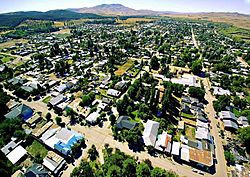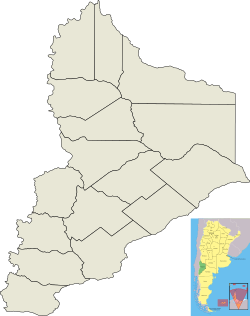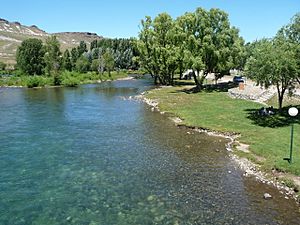Junín de los Andes facts for kids
Quick facts for kids
Junín de los Andes
|
|
|---|---|

Panoramic view of the city
|
|
| Country | |
| Province | Neuquén |
| Department | Huiliches |
| Founded | February 15, 1883 |
| Elevation | 902 m (2,959 ft) |
| Population
(2010 census [INDEC])
|
|
| • Total | 13,086 |
| Time zone | UTC−3 (ART) |
| CPA Base |
Q 8371
|
| Area code(s) | +54 02972 |
| Climate | Csb |
| Website | www.junindelosandes.gov.ar |
Junín de los Andes is a town in the Neuquén area of Argentina. It's the main town in the Huiliches Department. You can find it in the southern part of the province, right by the Chimehuin River.
This town was started in 1883 as a fort. It's the oldest town in the Neuquén province! Junín de los Andes grew into a place where people raised cattle. Today, you can see a mix of local Mapuche culture and the traditions of early Argentine settlers. It's also a popular spot for tourists. It's close to Lanín National Park and many beautiful lakes in the Andes mountains. In spring and summer, it's a great place for birdwatching and fishing. People even call it Argentina's capital for trout fishing!
Contents
History of Junín de los Andes
The area around Junín de los Andes, called Huiliches, was home to people long before European settlers arrived. Before the late 1800s, Mapuche and Tehuelche tribes lived here. They hunted and gathered food.
In 1882, the Argentine Army came to this region. They built a fort to protect their position. Commander Miguel E. Vidal is thought to have chosen the spot for the fort. He is seen as the founder of the town. The next year, an expedition went from the fort to the Chimehuin River valley to start a settlement. The army first wanted to name the town General Frías. But they changed it to Junín de los Andes. The name "Junín" comes from the Aymara word hunins, which means "pasture".
At first, Junín de los Andes was mostly a military base. In 1892, Salesian priests Domingo Melanesio and Juán Ruggerone arrived. They worked with the native people. They also opened a Salesian house with two schools for children. Over time, more settlers came, and the town grew into a place for raising cattle. The town was planned with a main square and wide streets. Some of the first buildings were built then. The original church was built in 1893, but it was torn down later. The post office opened in 1900. In 1945, the town officially became a municipality.
Geography and Landscape
Junín de los Andes sits on the left side of the Chimehuín River. It's in a low area in the northern part of the Patagonian Andes mountains. The land around the town has three main types of landscapes:
- The east has flat areas made of basalt rock with river valleys. Wind has shaped these areas, creating mountains and small hills.
- The center is a valley formed by glaciers. It has rivers and creeks with green, grassy banks.
- The west has large volcanoes like Lanín (which is 3,776 meters tall) and many lakes.
The rocks in this region are very old, from the Precambrian time. Newer minerals are found on top of these old rocks. There are also rocks formed by volcanoes. Many lakes are near the town. These include glacial lakes like Huechulafquen, Epulafquén, and Tromén. Rivers like Aluminé, Quilquihue, and Malleo also flow nearby.
Climate and Weather
Junín de los Andes has a climate called a warm-summer Mediterranean climate. This means it has warm, dry summers and mild, wet winters. The town is at the base of the Andes mountains and near lakes. This helps keep the weather mild.
- Summer (December to February): Days are mild to warm, usually between 20°C and 30°C. Nights are cooler, dropping to 5°C to 10°C.
- Winter (June to August): Most of the rain falls in the colder months from May to July. The town gets about 2000 mm of rain each year.
| Climate data for Junín de los Andes, Neuquén | |||||||||||||
|---|---|---|---|---|---|---|---|---|---|---|---|---|---|
| Month | Jan | Feb | Mar | Apr | May | Jun | Jul | Aug | Sep | Oct | Nov | Dec | Year |
| Mean daily maximum °C (°F) | 23.4 (74.1) |
23 (73) |
19.4 (66.9) |
14 (57) |
9.1 (48.4) |
5.2 (41.4) |
4.5 (40.1) |
6.2 (43.2) |
9.6 (49.3) |
13.2 (55.8) |
17.1 (62.8) |
20.6 (69.1) |
13.8 (56.8) |
| Daily mean °C (°F) | 16.2 (61.2) |
16 (61) |
13 (55) |
8.6 (47.5) |
4.9 (40.8) |
1.9 (35.4) |
0.9 (33.6) |
2.1 (35.8) |
4.3 (39.7) |
7.4 (45.3) |
10.7 (51.3) |
13.8 (56.8) |
8.3 (46.9) |
| Mean daily minimum °C (°F) | 9.6 (49.3) |
9.9 (49.8) |
7.7 (45.9) |
4.5 (40.1) |
1.9 (35.4) |
−0.6 (30.9) |
−1.7 (28.9) |
−1 (30) |
0.3 (32.5) |
2.6 (36.7) |
5.1 (41.2) |
7.7 (45.9) |
3.8 (38.9) |
| Average relative humidity (%) | 49.0 | 51.0 | 59.0 | 69.0 | 81.0 | 85.0 | 83.0 | 79.0 | 73.0 | 66.0 | 58.0 | 52.0 | 67.1 |
| Source: Climate Data.org | |||||||||||||
Plants and Animals
The Huiliches Department is very beautiful. It has green hillsides, typical of the northern Patagonian Andes. The area has two main types of natural environments: the Andean Patagonian forest and the Patagonian steppe.
Local plants include:
- Araucaria araucana trees (also called monkey puzzle trees)
- Different kinds of Nothofagus trees, like coihues and Patagonian oaks
- Andean cypresses
Many animals live in this region. They are found in the mountains, lakes, and rivers. Most local species live in national parks. This helps protect them from hunting.
Some of the mammals you might find are:
- South Andean deer
- Andean fox
- Pudú (a small deer)
Bird species include:
The rivers and lakes are full of fish, such as:
- Neotropical silversides
- Aplochiton taeniatus
- Perches
- Different types of trout, like rainbow and brown trout
Economy and Tourism
The economy of the Huiliches Department mainly relies on tourism and growing fruit. Junín de los Andes is also known for raising cattle. Since 1942, it has hosted the Neuquén Rural Society's yearly show.
The Lanín National Park and other natural spots make the area popular for visitors. People enjoy trekking, hiking, and other outdoor activities. Because the Chimehuín River and nearby lakes are great for fishing, the town is known as Argentina's capital for sport trout-fishing. Many services are available for those who want to fish.
Landmarks and Local Culture
You can see the mix of Mapuche culture and Argentine pioneer traditions in daily life in Junín de los Andes. This mix is found in art and in the people themselves. The Vía Christi park on the Cerro de la Cruz ("Hill of the Cross") shows this. It has Catholic themes but also includes local elements. This shows the strong religious faith of the people. The government has worked to keep the native culture alive. They have included the town in the province's Mapuche tourist trail. They also started a Mapuche cultural center.
The Our Lady of las Nieves church is in the town center. It is dedicated to Blessed Laura Vicuña, who lived in Junín de los Andes in 1904. The church has Gothic architecture features, like arched ceilings. Its walls are decorated with Mapuche looms. The altar rests on four rocks from the Huechulafquen lake. This shows how different cultures' beliefs come together.
The remains of blessed young Mapuche Ceferino Namuncurá are in the small village of San Ignacio. This village is about 60 km from Junín de los Andes. The sanctuary was built to look like a giant cultrun drum. It has wooden walls, a metal roof, and diamond-shaped windows with colorful glass. Many people visit this sanctuary as a pilgrimage site in Neuquén province.
The María Auxiliadora del Paimún chapel is at the base of the Lanín volcano. It's on the shore of Paimún lake. Inside, there is a statue of Mary Help of Christians, who is the Patroness of Patagonia. The chapel has two towers. One has a round, onion dome top. It also has a 400 kg bell made of bronze and tin. The entrance area shows pictures of the three stages of the evangelisation process in Neuquén province. The altar is made from Patagonian cypress wood.
Some old buildings from the early days of Junín de los Andes are still standing. This includes the first post office, built in 1901. The San Martín square was planned as the town's main square in 1897. It was officially opened in 1950. It is decorated with the special araucaria trees found in Neuquén province. You can also visit the Municipal Museum and Historical Archive to learn more about the region's past.
Yearly Events and Festivals
Junín de los Andes hosts several yearly events that celebrate its culture.
- Junín Rural Expo: This is a big cattle event held every January at the Neuquén Rural Society. It's one of the most important rural shows in Argentine Patagonia.
- Camp Tender Festival: Held in February, this festival celebrates rural traditions. It features horse riding contests, Argentine folk music, and other parts of the gaucho lifestyle.
- National Trout Festival: This fishing contest and festival takes place in November. It includes food stands, music shows, and fishing activities. Fishermen from all over Neuquén and other provinces come to join.
Transportation and Travel
The National Route 40 goes through Junín de los Andes from north to south. It connects the city with Zapala to the north and San Martín de los Andes to the south. Provincial Route 23 ends where it meets Route 40, north of town. Provincial Route 61 connects the town to Lake Huechulafquén.
From Junín de los Andes, you can cross into Chile using several mountain passes:
- Mamuil Malal Pass (via Provincial Route 60)
- Carirriñe Pass (63 km west of town via Provincial Route 62)
- Hua Hum Pass (via San Martín de los Andes)
The town has a bus terminal. You can take long-distance and medium-distance buses from here to other places in Neuquén province and the rest of Argentina. The main airport for southern Neuquén province is the Aviador Carlos Campos Airport. It's near San Martín de los Andes and has regular flights to Buenos Aires. Within Junín de los Andes, there is a bus network for public transportation.
Images for kids
See also
 In Spanish: Junín de los Andes para niños
In Spanish: Junín de los Andes para niños








